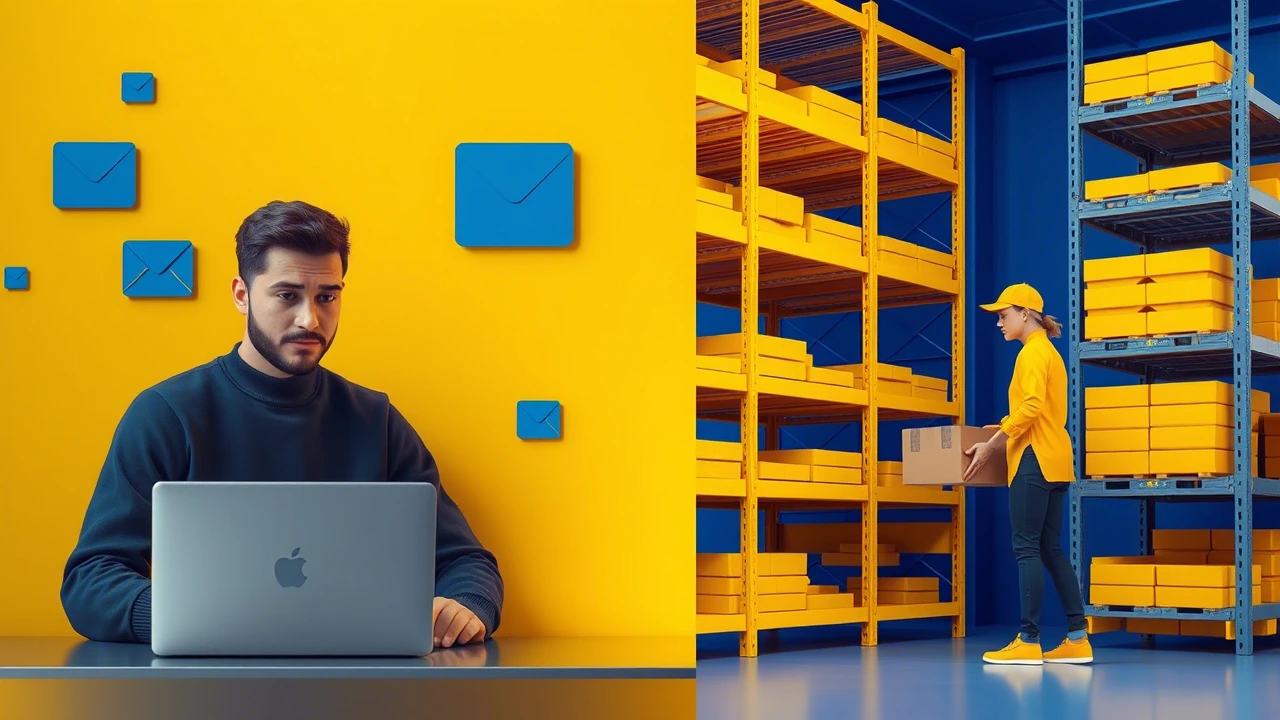- Retail SEO Explained : The Ultimate Beginner’s Guide - June 17, 2025
- Keyword Research for SEO in 2025: The Complete Step-by-Step Guide - June 16, 2025
- How Do Search Engines Work? The Beginners Guide - June 2, 2025
In the busy online marketplace, with countless products available within fingertips on any device, how can a retail business (from a small local retailer to a large online retailer) find their ideal customers? The answer lies within a large and vital method: retail Search Engine Optimization (SEO). This comprehensive guide will show you what retail SEO is, along with a simple, step-by-step guide for beginners to improve your online visibility, obtain qualified traffic and increase sales.
What is Retail SEO & Why Does It Matter to Your Business?
Retail SEO is the practice of optimizing your online store and web pages to rank better in search engine results pages (SERPs) for relevant search terms. You can think of it as the digital equivalent of choosing the right spot for a brick-and-mortar store. The better the spot (i.e., the higher your ranking on Google), the more foot traffic (i.e., the more visits to your website).
Retail SEO is important because a disproportionate number of consumers start their shopping experience on a search engine. When someone types in “women’s running shoes” or “best organic coffee beans” into Google, they are intending to make a purchase. When you rank high for those specific results, you place your brand directly in front of motivated buyers that are looking for the products you sell, at the exact time they want them.
A good retail SEO strategy helps your business in several ways:
More free traffic – Show up in search results when people look for products you sell, without paying for ads.
Builds trust – Ranking higher makes your brand look more reliable and professional.
Better customers – Reach people who are actually ready to buy, not just browsing.
Saves money – Works long-term without constant ad spending, giving you more bang for your buck.
Beats competitors – Get seen before other stores in search results.
Helps online & offline sales – Brings shoppers to your website and physical stores if you have them.
Retail SEO Essentials: A Roadmap for Beginners
Understanding Retail SEO can come off as overwhelming at first, but we can actually split it up into four simple pillars.
If you focus on these four pillars, it will give you a strong strategy to see results from retail SEO.
A Simple Guide to Finding the Right Search Terms for Your Shop:
Start with the Basics: Think like your customer. What main words would they type to find what you sell? (e.g., If you sell handmade leather bags: “leather bags,” “handmade purses”).
Figure Out What They Really Want: Why are they searching?
Just Looking? (“how to clean leather bag”)
Looking for You? (“[Your Brand Name] bags”)
Ready to Buy? (“buy brown leather tote bag”) <– Target these hardest!
Use Free & Paid Helpers: Tools like Google’s Keyword Planner (free) or Ahrefs/SEMrush (paid) show you:
How many people search for a word?
How tough is it to show up for that word?
What other similar words are people using?See What Competitors Do: Check what search terms other successful shops like yours are using. You might find good ones you missed!
Go for Specific Phrases: Target longer, more detailed searches (e.g., “handmade vintage leather crossbody bag for women”). Fewer people search for these exact phrases, but the people who do are much more likely to be ready to buy that exact thing.

On-Page SEO: Fine Tuning Your Online Storefront
On-page SEO is when we optimize the pages on your sites beloved store for search engines. For retailers, our focus is mainly on your homepage, category pages, and product pages.
On-Page SEO Best Practices for Retail:
• Compelling & Keyword-Rich Title Tags: The title tag is the clickable headline that’s displayed on search results. Take advantage off excellent title tags by putting your primary keyword in the tag, and encouraging users to click. For example, a solid title tag for a product page would be “The Artisan’s Brown Leather Tote Bag | Like Milton ”.
• Meta Descriptions that Inform: This is the snippet of text that appears below the title on the SERPs. Regardless of the page, the meta description was not established as contributing to ranking signals, but improving click-thorough is substantial source of USER signals. Write meta descriptions to condense the content of the page into a compelling meta description with a call to action.
• Unique Product Descriptions: Never borrow product descriptions from the manufacturer. Write unique, longer, more descriptive, and persuasive product descriptions. Identify relevant keywords to sprinkle throughout your description. Don’t forget to;
Write product descriptions with the benefits and features of the product in mind.
-High-Quality Product Images with Alt Text: Utilize high-quality images with different perspectives. Alt text is a brief description of the photo so that search engines understand how to rank the image. Use descriptive alt text to represent the specific photo while including relevant keywords (example: A woman holding The Artisan’s brown leather tote bag).
-Clean and Consistent URL structure: Your URLs should be clean, readable, and include keywords. Example: yourstore.com/womens-shoes/running-shoes/product-name
-Internal Linking: Link to other relevant pages on your site. For example, on a product page for a camera, link to a category-level page with camera lenses or a blog post with photography tips.
-Customer Ratings and Reviews: User-generated content like reviews and ratings can add extra trust and also add new relevant content for search engines.
3. Technical SEO: Ensuring a Smooth Shopping Experience
Technical SEO focuses on the backend of your website, ensuring that it’s easy for search engines to crawl and index. A technically sound website also provides a better user experience, which is a crucial ranking factor.
Common Technical SEO Issues for Retail Sites and Their Solutions:
- Slow Page Speed:A slow-loading website is a major turn-off for users and can negatively impact your rankings. Use Google’s PageSpeed Insights to test your site’s speed and get recommendations for improvement. Compressing images and leveraging browser caching are common solutions.
- Mobile-Friendliness:With a significant portion of online shopping happening on mobile devices, having a mobile-responsive website is non-negotiable. Your website should automatically adjust to fit any screen size.
- Duplicate Content:Duplicate content can confuse search engines and dilute your ranking potential. This can happen with product variations (e.g., different colors of the same shirt having separate URLs with identical descriptions). Use canonical tags to tell search engines which version of a page is the preferred one.
- XML Sitemap: An XML sitemap is a file that lists all the important pages on your website, making it easier for search engines to discover and crawl them. Most e-commerce platforms can automatically generate an XML sitemap.
- Secure Website (HTTPS):Ensure your website uses HTTPS encryption. This is a crucial trust signal for both users and search engines, especially for e-commerce sites that handle sensitive customer information.
4. Off-Page SEO: Building Your Brand’s Authority
Off-page SEO refers to activities that take place outside of your website to improve its authority and reputation. For retail businesses, this largely revolves around building high-quality backlinks.
Beginner’s Guide to Link Building for Retail:
- What are Backlinks?Backlinks are links from other websites to yours. Search engines view backlinks as votes of confidence. The more high-quality backlinks you have, the more authoritative your website appears.
- Guest Blogging:Write articles for reputable blogs in your niche and include a link back to your website in your author bio.
- Product Reviews from Bloggers and Influencers:Reach out to relevant bloggers and influencers and offer them a free product in exchange for an honest review that includes a link to your product page.
- Broken Link Building:Find broken links on other websites that are relevant to your niche and suggest your own content as a replacement.
- Unlinked Brand Mentions:Use tools to find mentions of your brand online that don’t include a link. Reach out to the website owner and politely request that they add a link.
Local SEO: Bridging the Gap Between Online and In-Store
For retail businesses with physical locations, local SEO is a game-changer. It helps you appear in location-based searches, such as “shoe store near me.”
Local SEO Checklist for Retail Stores:
- Claim and Optimize Your Google Business Profile:This is a free and powerful tool that allows you to manage your online presence across Google, including Search and Maps. Ensure all your information is accurate and complete, including your address, phone number, hours of operation, and photos.
- Encourage Customer Reviews:Positive reviews on your Google Business Profile and other local directories can significantly improve your local search rankings.
- Local Keyword Targeting:Include location-specific keywords in your website content, such as your city or neighborhood.
- Build Local Citations:Get your business listed in online directories like Yelp, Yellow Pages, and industry-specific directories. Ensure your name, address, and phone number (NAP) are consistent across all listings.
Content Marketing: Engaging Your Audience and Driving Sales
Content marketing is a strategic approach to creating and distributing valuable, relevant, and consistent content to attract and retain a clearly defined audience. For retail businesses, content marketing can take many forms.
Content Marketing Examples for Retail Brands:
- Buying Guides and “How-To” Articles:Create in-depth guides that help customers make informed purchasing decisions (e.g., “The Ultimate Guide to Choosing the Perfect Running Shoes”).
- Blog Posts on Related Topics:If you sell kitchenware, you could write blog posts with recipes, cooking tips, or interviews with chefs.
- Video Content:Create product demonstration videos, behind-the-scenes looks at your brand, or customer testimonials.
- User-Generated Content Campaigns:Encourage customers to share photos of themselves using your products on social media with a specific hashtag.
Measuring Your Retail SEO Success
To understand what’s working and where you can improve, it’s essential to track your SEO performance.
Key Metrics to Monitor:
- Organic Traffic:The number of visitors coming to your site from search engines.
- Keyword Rankings:Your position in the SERPs for your target keywords.
- Conversion Rate:The percentage of visitors who make a purchase.
- Click-Through Rate (CTR):The percentage of users who click on your website in the search results.
- Bounce Rate:The percentage of visitors who leave your site after viewing only one page.
Tools like Google Analytics and Google Search Console are invaluable for tracking these metrics.
The Future of Retail SEO: Whats Next
The world of SEO is constantly evolving. Here are a few trends that will shape the future of retail SEO:
- Artificial Intelligence (AI):AI is becoming increasingly integrated into search engines, leading to more personalized and context-aware search results.
- Voice Search:As smart speakers and voice assistants become more popular, optimizing for conversational, long-tail keywords will be crucial.
- Visual Search:The ability to search using images is on the rise. Optimizing your product images will become even more important.
- User Experience (UX):Search engines will continue to prioritize websites that offer a seamless and enjoyable user experience.

